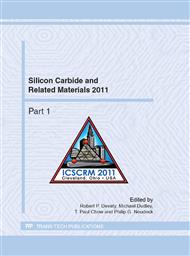p.379
p.383
p.387
p.391
p.395
p.399
p.403
p.407
p.411
Photoluminescence Study of the Driving Force for Stacking Fault Expansion in 4H-SiC
Abstract:
We investigated expansion velocities of Shockley stacking faults (SSFs) in 4H-silicon carbide under laser illumination using photoluminescence methods. The experiments showed that the velocity of SSF expansion or the glide velocity of SSF-bounding 30°-Si(g) partial dislocations (PD) is supralinearly dependent on the excitation intensity. We estimated sample temperature by analyzing the broadening of band-edge emission and concluded that the lattice heating by laser illumination is not the cause of the enhanced dislocation glide. The supralinear dependence can be accounted for by a photo-induced sign reversal of the effective formation energy of SSF acting as the driving force of SSF expansion under the illumination.
Info:
Periodical:
Pages:
395-398
Citation:
Online since:
May 2012
Authors:
Price:
Сopyright:
© 2012 Trans Tech Publications Ltd. All Rights Reserved
Share:
Citation:


